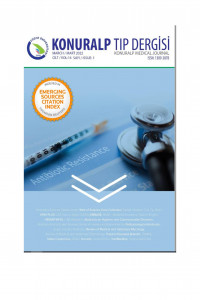Abstract
Elizabethkingia anophelis, Flavobacteriaceae familyasına ait Gram negatif, aerobik, hareketsiz basildir. Son yıllarda özellikle bağışıklığı baskılanmış hastalarda yaşamı tehdit eden enfeksiyonların bir nedeni olarak ortaya çıkmıştır. Hastane ortamında kolonize olabilen bakteri, dekontaminasyona dirençlidir. E. anophelis, antibiyotiklere karşı oldukça dirençli bir bakteridir. Bu çalışmada, optik gliom tanısı nedeniyle yoğun bakımda takip edilirken, ateş etyolojisini araştırmak için gönderilen eş zamanlı trakeal aspirat ve idrar kültürü örneklerinde E. anophelis üremesi olan 6 aylık bebek hasta sunulmuştur. Bakteri identifikasyonu VITEK MS® sistemi, antibiyotik duyarlılık testleri ise VITEK 2 otomatize sistemi ve gradient strip test kullanılarak yapılmıştır. Olgumuz Türkiye’den bildirilen ikinci E.anophelis olgusudur. Bu vaka, ülkemizde de bu bakterinin artık etken olarak karşımıza çıkmaya başlayacağını göstermiştir. Bu bakteri hakkında daha detaylı bilgi edinilebilmesi, bulaşma yolları, direnç mekanizmalarının belirlenerek uygun tedavi protokollerinin oluşturulabilmesi için daha fazla çalışmaya ihtiyaç vardır.
References
- 1. Lin JN, Lai CH, Yang CH, Huang YH. Elizabethkingia Infections in Humans: From Genomics to Clinics. Microorganisms. 2019;7(9):295.
- 2. Kim KK, Kim MK, Lim JH, Park HY, Lee ST. Transfer of Chryseobacterium meningosepticum and Chryseobacterium miricola to Elizabethkingia gen. nov. as Elizabethkingia meningoseptica comb. nov. and Elizabethkingia miricola comb. nov. Int J Syst Evol Microbiol. 2005; 3:1287-93.
- 3. Frank T, Gody JC, Nguyen LB, et al. First case of Elizabethkingia anophelis meningitis in the Central African Republic. Lancet. 2013;381(9880):1876.
- 4. Lau SK, Chow WN, Foo CH et al. Elizabethkingia anophelis bacteremia is associated with clinically significant infections and high mortality. Sci Rep. 2016;6:26045 .
- 5. Centers for Disease Control and Prevention (CDC) 2005. https://www.cdc.gov/elizabethkingia/outbreaks/index.html. Access Date: May 5, 2020.
- 6. Perrin A, Larsonneur E, Nicholson AC et al. Evolutionary dynamics and genomic features of the Elizabethkingia anophelis 2015 to 2016 Wisconsin outbreak strain. Nat Commun. 2017;8:15483
- 7. Wang M, Gao H, Lin N, et al. The antibiotic resistance and pathogenicity of a multidrug-resistant Elizabethkingia anophelis isolate. Microbiologyopen. 2019;8.11:e804.
- 8. Mirza Hasan Cenk, Tuncer Ö, Ölmez S, et al. Clinical strains of Chryseobacterium and Elizabethkingia spp. isolated from pediatric patients in a university hospital: performance of MALDI-TOF MS-based identification, antimicrobial susceptibilities, and baseline patient characteristics. Microbial Drug Resistance. 2018; 24.6: 816-21.
- 9. Kämpfer P, Busse H J, McInroy J, et al. Elizabethkingia endophytica sp. nov., isolated from Zea mays and emended description of Elizabethkingia anopheles. International Journal of Systematic and Evolutionary Microbiology. 2015;65(7):2187-93.
- 10. Yung CF, Maiwald M, Loo LH, et al. Elizabethkingia anophelis and Association with Tap Water and Handwashing, Singapore. Emerg Infect Dis. 2018; 24(9):1730-33.
Abstract
Elizabethkingia anophelis is a Gram-negative, aerobic, nonmotile bacillus belonging to the Flavobacteriaceae family. In recent years, it has emerged as a cause of life-threatening infections, especially in immunocompromised patients. In this study, a 6-month-old baby patient with E. anophelis growth in simultaneous tracheal aspirate and urine culture samples sent to investigate the etiology of fever while being followed in the intensive care unit due to the diagnosis of optic glioma is presented. Bacteria identification was performed using the VITEK MS® system, antibiotic susceptibility tests were performed using the VITEK 2 automated system and gradient strip test. Our case is the second E.anophelis case reported from Turkey. This case showed that this bacterium would start to appear as a factor in our country. More studies are needed to obtain more detailed information about this bacterium, to determine its transmission routes and resistance mechanisms and to establish appropriate treatment protocols.
References
- 1. Lin JN, Lai CH, Yang CH, Huang YH. Elizabethkingia Infections in Humans: From Genomics to Clinics. Microorganisms. 2019;7(9):295.
- 2. Kim KK, Kim MK, Lim JH, Park HY, Lee ST. Transfer of Chryseobacterium meningosepticum and Chryseobacterium miricola to Elizabethkingia gen. nov. as Elizabethkingia meningoseptica comb. nov. and Elizabethkingia miricola comb. nov. Int J Syst Evol Microbiol. 2005; 3:1287-93.
- 3. Frank T, Gody JC, Nguyen LB, et al. First case of Elizabethkingia anophelis meningitis in the Central African Republic. Lancet. 2013;381(9880):1876.
- 4. Lau SK, Chow WN, Foo CH et al. Elizabethkingia anophelis bacteremia is associated with clinically significant infections and high mortality. Sci Rep. 2016;6:26045 .
- 5. Centers for Disease Control and Prevention (CDC) 2005. https://www.cdc.gov/elizabethkingia/outbreaks/index.html. Access Date: May 5, 2020.
- 6. Perrin A, Larsonneur E, Nicholson AC et al. Evolutionary dynamics and genomic features of the Elizabethkingia anophelis 2015 to 2016 Wisconsin outbreak strain. Nat Commun. 2017;8:15483
- 7. Wang M, Gao H, Lin N, et al. The antibiotic resistance and pathogenicity of a multidrug-resistant Elizabethkingia anophelis isolate. Microbiologyopen. 2019;8.11:e804.
- 8. Mirza Hasan Cenk, Tuncer Ö, Ölmez S, et al. Clinical strains of Chryseobacterium and Elizabethkingia spp. isolated from pediatric patients in a university hospital: performance of MALDI-TOF MS-based identification, antimicrobial susceptibilities, and baseline patient characteristics. Microbial Drug Resistance. 2018; 24.6: 816-21.
- 9. Kämpfer P, Busse H J, McInroy J, et al. Elizabethkingia endophytica sp. nov., isolated from Zea mays and emended description of Elizabethkingia anopheles. International Journal of Systematic and Evolutionary Microbiology. 2015;65(7):2187-93.
- 10. Yung CF, Maiwald M, Loo LH, et al. Elizabethkingia anophelis and Association with Tap Water and Handwashing, Singapore. Emerg Infect Dis. 2018; 24(9):1730-33.
Details
| Primary Language | English |
|---|---|
| Subjects | Health Care Administration |
| Journal Section | Case Report |
| Authors | |
| Publication Date | March 14, 2022 |
| Acceptance Date | October 20, 2021 |
| Published in Issue | Year 2022 Volume: 14 Issue: 1 |
Cite




